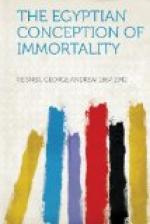In the Middle Empire, which is the period under discussion, the process of mummification had reached a middle stage, and, while we are unable to explain exactly the causal relationship, it is clear that this advance in the treatment of the body accompanied a spread of the belief in the Osirian immortality.
VII. THE NEW EMPIRE
The New Empire (1600-1200 B.C.) was the great period of foreign conquest. The Hyksos, Asiatic invaders, had held Egypt for a century or more. The Theban princes who drove them out became kings of Egypt, and followed them into Asia. With an army trained in war by the long struggle with the Hyksos, the Egyptian kings, having tasted the sweetness of the spoils of war, entered on the conquest of western Asia and the Sudan. The plunder of both these regions poured into Egypt. Under Thothmes III an annual campaign was conducted into Syria to bring back the spoils and the tribute. Foreign slaves and the products of foreign handicraft were for sale in every market-place. The treasury was filled to overflowing. A large share was assigned to Amon, the god of the Theban family. Temples were built for him; estates established for the maintenance of his rites; thousands of priests enrolled for the service of his properties. The god became, in a material sense, the greatest god of Egypt, the national god; and his priesthood became the most powerful organization in the kingdom. The high priest of Amon usurped the power of the king and finally supplanted him. Such was the period in which the next great development of the Egyptian idea of immortality is to be noted— a period of priestly activity in the beginning and of priestly domination in the end.
The priests are the scribes, the men of learning. They have the lore of all magic, medicine, rules of conduct, religious rites. It is not mere chance, therefore, that the New Empire was marked by a great increase of magic in all its forms—texts and symbolic objects—and by a great development in the knowledge of the other world. In some of the texts the geography of the underworld, in which Osiris is king, is worked out in great detail. When the sun sets in the west, Ra in his boat enters the underworld and passes through it during the twelve hours of the night, bringing light and happiness to those who are in the underworld. In the effort to secure the tomb against plundering, the royal graves had been cut in the solid rock,—long and complicated passages with false leads and deceptive turns and the burial chamber in an unexpected place. The long walls of these rooms presented a great surface suitable to decoration, and they were utilized to depict scenes from the underworld and the passage of Ra through it, so that the tombs became in fact representations of the land of the dead, and were so considered. These royal tombs were at a distance from the cultivated land, hidden in valleys in the desert. Their funerary temples were built on the edge of the desert beside the temples of the gods of the place.




